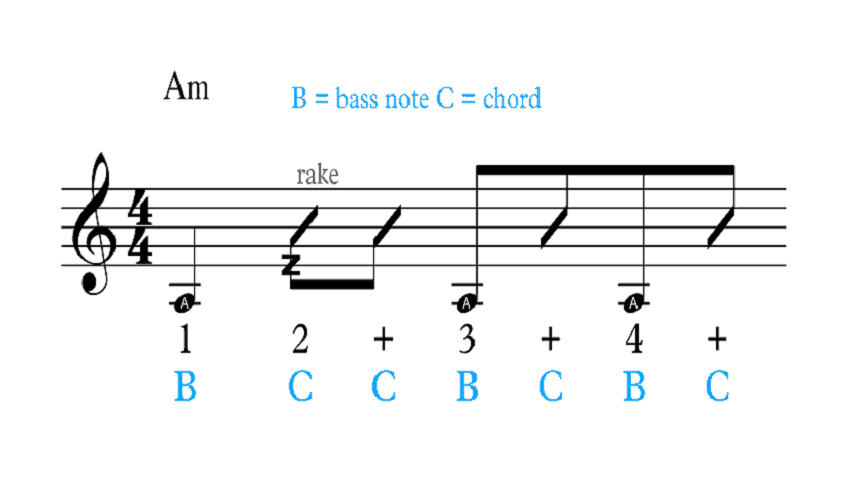Rhythm Pattern: Mastering “The Rake”
This is a Fingerstyle Latin guitar rhythm pattern. You'll find this whole thing much easier if you practice “the rake” ahead of time.
Important Tip: One thing that helped me the most to learn this and other rhythm patterns. I listened to the rhythm pattern over and over until it became clearly fixed in my mind. My hands begin to re-create what I heard in my mind.
This does take patience and focus. In addition to listening to the pattern, the key is to re-create it in your mind. Listen to the pattern… Try to hear it in your head.
Then… listen to the pattern… Try to hear your head. I'm repeating this process over and over. The make sense?
Now I'll go ahead and explain what you're doing. Intellectualizing the pattern is a slow route to mastery, but it can help if you think it out in addition to listening and re-creating the pattern. That way you're coming at it from different ways. Just don't get caught up in thinking about it only.
To create the raking sound you pull your three fingers off the strings one after the other starting with the first finger. The first finger starts pulling off a little before the actual beat. The 3rd finger pulls off right on the beat. In other words you start the technique in anticipation of ending it right on the beat.
Creating The Groove
This rhythm pattern is a 4 beat pattern. Beat 1 is the bass note. The down beat of beat 2 is the rake. The upbeat of beat 2 is a solid chord… all fingers come off at the same time.
What I just described was the first 2 beats, or the 1st half of the pattern. Let's go on to the 2nd half.
On the downbeat of beat 3 you hit the bass note your thumb, then on the upbeat a solid chord. Same thing on beat 4… Downbeat hit the bass note, on the upbeat play a solid chord.
Here's what it looks like in diagram form:

The Chord Progression Is Easy… If You Know Bar Chords
If you know bar chords you'll find this chord pattern fairly easy. If you haven't ventured into bar chords yet I'd recommend checking out my lesson How To Play Bar Chords With Ease And Grace. You'll avoid a lot of stress and bad habits by following a simple system like the one I outline in this free lesson.
So on with the progression…
Starting with the A minor bar chord you'll play one rhythm pattern. Then go on to the D minor 7 and play one rhythm pattern. Then play two rhythm patterns with the E7 chord. This makes up one for bar phrase that looks like this:
| Am///| Dm7///| E7///| ////|
I like to look for patterns in the song. I find it much more efficient to learn to recognize parts that repeat and parts that sound like complete phrases. In this case we're going to repeat that same phrase again. Once you've repeated it you'll I played 8 bars… That half of the tune.
It's going to the 2nd half. Will break that into 4 bar phrases as well.
Play one rhythm pattern of G, then one rhythm pattern of A minor. Repeat that. That's one phrase of 4 bars.
| G///| Am///| G///| Am///|
Next phrase…
2 bars of D minor 7 (that's 2 rhythm patterns… Same thing). Then one bar of the F7 chord. Now and the 2nd half with one bar of the E7 chord. You've just completed the 2nd half. Here's what that last 4 bar phrase looks like:
| Dm7///| ////| F7///| E7///|
Notice there's a strong feeling with the E7 to go back to the beginning A minor chord. Make sure and download the cheatsheet which includes the entire chord progression so you can see all 16 bars laid out in order.
By recognizing the phrases and repeating patterns it will be easier to memorize this pattern and learn new progressions in the future.

Hi Thomas just to say t.hankyou for the soft rumba lesson, I really liked it and want more, so many thanks Tony. Bw
You’re welcome Tony.
helo thomasmichel glad see you ser.long time
I really appreciate the continual updates, however my wife does not appreciate my practicing and disappears to bed. I am desperate to learn something simple and pleasing to the ear, to have her want to stay and listen. I was born in 1949 and really enjoyed 60’s music. However all too often, modern songs are offered on you tube, which is a waste of time, because I don’t know the music! Cheers Mark M
Hey Tomas
Thanks for the delightful little progression. I went to download the chord progression cheat sheet. But it appears to the the A Minor scale from a previous session. Thought you would want to know so it could be fixed.
Looking forward to learning this!
Thanks Michael
Thanks Michael. I will get this fixed.
– Tomas
Thanks Tomas, I always enjoy your lessons, and really appreciate all the extras you provide.
You’re welcome Alan.
Cheers tomas. U make it enjoyable to keep going with my guitar..easy to follow instructions and vids. The amount of encouragement u give us is truly greatfull.. thanks
I’m glad you’re enjoying the lesson Tom. Thanks for commenting. – Tomas